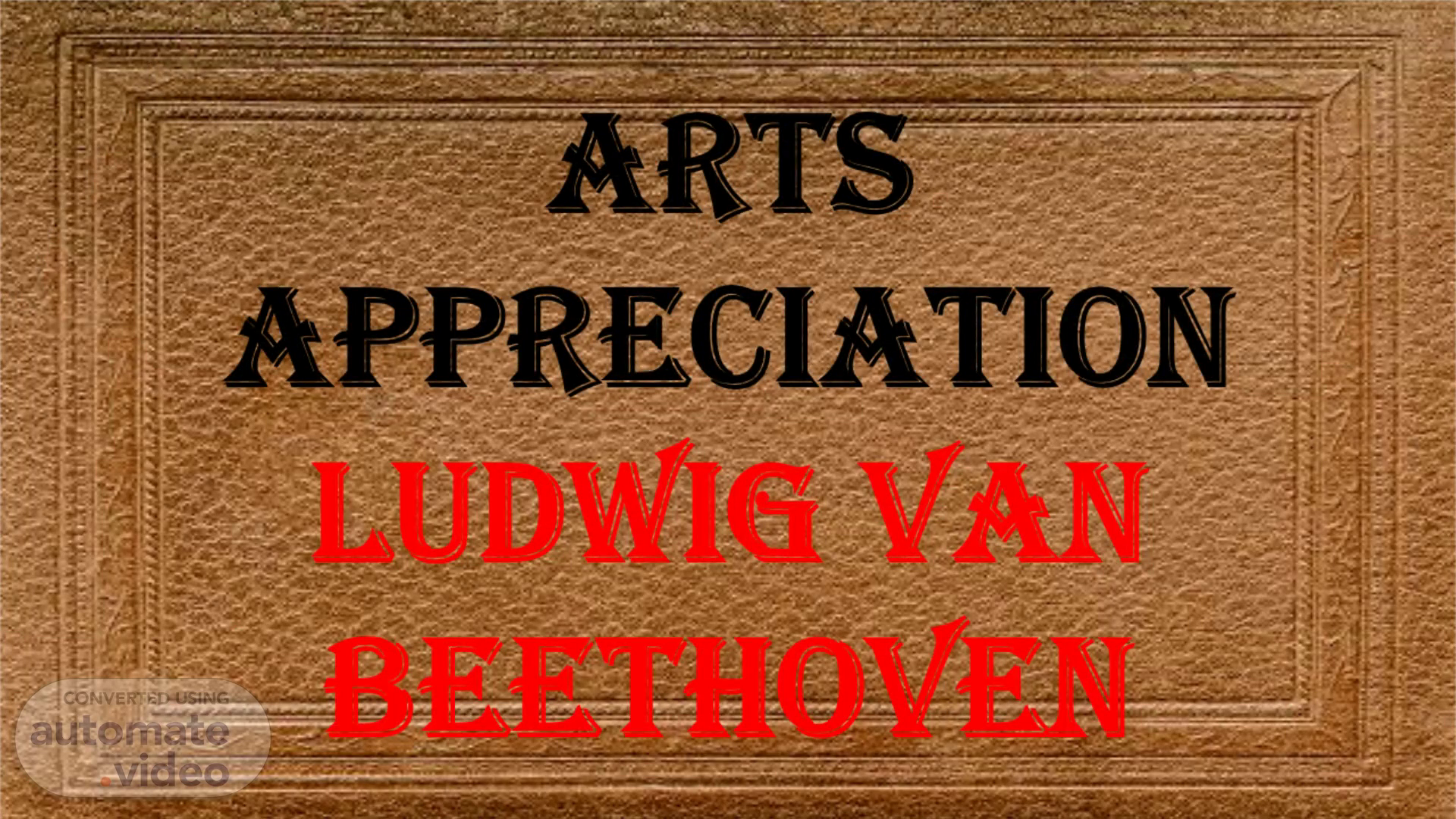
PowerPoint Presentation
Scene 1 (0s)
ARTS APPRECIATION LUDWIG VAN BEETHOVEN.
Scene 2 (7s)
LUDWIG VAN BEETHOVEN was a German composer and pianist. Beethoven remains one of the most admired composers in the history of Western music; his works rank amongst the most performed of the classical music repertoire and span the transition from the Classical period to the Romantic era in classical music..
Scene 3 (32s)
He was born on December 16, 1770 in Bonn, Germany. His father, who was a singer, was his first teacher. After a while, even though he was still only a boy, Ludwig became a traveling performer, and soon, he was supporting his family..
Scene 4 (59s)
1778, March 26th - Has his first public concert. 1780 - Becomes Neefe’s student..
Scene 5 (1m 29s)
Beethoven moved to Vienna in 1792, where he met influential composers like Haydn and began to compose in earnest..
Scene 6 (1m 51s)
He became Josef Haydn’s pupil 1794 – The first symptoms of the deafness appear. Composes a trio for piano, Op.1. On the 29 th of March, he holds his first concerto at The Burgtheater. 1796 – February-June – goes to Nuremberg, Prague, Dresden and Berlin, where he composes the Sonata for Violoncello Op.5. He also composes the sonata for Piano Op.2..
Scene 7 (2m 21s)
Ludwig van Beethoven charted a powerful new course in music. His ideas may have been rooted in the work of European predecessors Wolfgang Amadeus Mozart and Josef Haydn, but the iconic German composer became who he was with the help of some familiar American values: life, liberty and the pursuit of happiness..
Scene 8 (2m 45s)
Today, Beethoven’s music remains deeply connected with a true humanism, which has the principles of freedom and self-determination at its heart. The composer’s music grew out of the age of European Enlightenment, which located human reason and the self at the centre of knowledge..
Scene 9 (3m 6s)
Beethoven’s music is universally beloved, revered and has over time generated a consensus that it is a true reflection of humanism. Out of this, Beethoven as composer and artist contained a certain political content which is reflected throughout history by the public reception of his works..
Scene 10 (3m 32s)
Beethoven’s stylistic innovations bridge the Classical and Romantic periods. The works of his early period brought the Classical form to its highest expressive level, expanding in formal, structural, and harmonic terms the musical idiom developed by predecessors such as Mozart and Haydn..
Scene 11 (4m 1s)
Beethoven’s greatest achievement was to raise instrumental music, hitherto considered inferior to vocal, to the highest plane of art. During the 18 th century, music, being fundamentally nonimitative, was ranked below literature and painting..
Scene 12 (4m 26s)
Quite simply the most important symphony ever written by any composer in the history of the world. Ever. Beethoven, at the age of 32, had finally confronted his deafness, and determined to overcome it. This is the beginning of his ‘Heroic’ phase. It was originally dedicated to Napoleon, but Beethoven scratched his name off the title page when he learned he had declared himself ‘Emperor’. Those two opening chords signalled a new era in music..
Scene 13 (4m 53s)
This is the middle of the final set of three piano sonatas Beethoven composed. In it he tells us of his deafness, the pain it has caused him, and how he overcame it. He set his 35 piano sonatas as his ‘autobiography’ ..
Scene 14 (5m 17s)
Beethoven has finally shaken off the influence of Mozart. The first movement has a richness and complexity beyond the earlier two. The slow movement is almost hymn-like, with a scale towards the end in which the 7 th note is flattened. Just in case you think it is a mistake, he repeats it in the next bar. Beethoven the master has emerged..
Scene 15 (5m 46s)
The most famous bars in all classical music open this symphony. Yet it is not a tune, a melody. It is a motif. For the first time in any symphony by any composer, Beethoven carries the motif right through the symphony. Again, for the first time, he uses trombones, piccolo, and contra-bassoon in a symphony..
Scene 16 (6m 9s)
The highest placed piece by Beethoven in the Classic FM Hall of Fame. The huge opening runs on piano – signalling something extraordinary to come – a slow movement breathtaking in its beauty, leading straight into a syncopated finale. The name was given to it by Beethoven’s English publisher. Beethoven disapproved..
Scene 17 (6m 32s)
This was the last piece Beethoven performed in public, due to the worsening of his deafness. Dedicated to his greatest patron, the trio has a joyous first movement, but the slow movement is one of his loveliest. This piece is played without thinking of the pain he felt at knowing he would no longer perform in public..
Scene 18 (6m 54s)
Ludwig van Beethoven was a German pianist and composer widely considered to be one of the greatest musical geniuses of all time. His innovative compositions combined vocals and instruments, widening the scope of sonata, symphony, concerto and quartet..
Scene 19 (7m 15s)
Beethoven’s importance in Musical History is that his work marks the end of the Classical period of classical music and the beginning of the Romantic period. The symphony was an invention of Classical music, developed to show off the increasingly large orchestra..
Scene 20 (7m 43s)
Beethoven’s greatest achievement was to raise instrumental music, hitherto considered inferior to vocal, to the highest plane of art..
Scene 21 (8m 8s)
There are no historical records of Beethoven winning any awards, though that was not as common during his time..